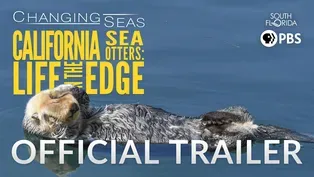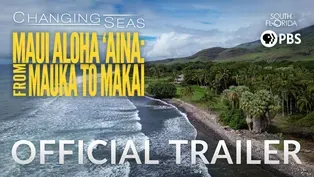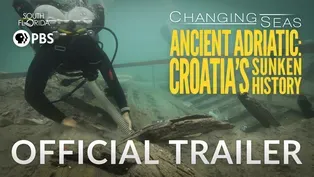Changing Seas
Ancient Adriatic: Croatia's Sunken History | Changing Seas | Preview
Preview: Season 16 | 5m 30sVideo has Closed Captions
Changing Seas Season 16 - Official Trailer
Archaeologists and conservators along Croatia’s Dalmatian Coast meticulously uncover and document an ancient Roman ship. Submerged in sediment for nearly 2000 years, the preserved wooden hull and recovered artifacts offer invaluable insights into the region's maritime history and cultural heritage.
Problems with Closed Captions? Closed Captioning Feedback
Problems with Closed Captions? Closed Captioning Feedback
Changing Seas is presented by your local public television station.
Major funding for this program was provided by The Batchelor Foundation, encouraging people to preserve and protect America’s underwater resources. Additional Funding was provided by Trish and Dan Bell and...
Changing Seas
Ancient Adriatic: Croatia's Sunken History | Changing Seas | Preview
Preview: Season 16 | 5m 30sVideo has Closed Captions
Archaeologists and conservators along Croatia’s Dalmatian Coast meticulously uncover and document an ancient Roman ship. Submerged in sediment for nearly 2000 years, the preserved wooden hull and recovered artifacts offer invaluable insights into the region's maritime history and cultural heritage.
Problems with Closed Captions? Closed Captioning Feedback
How to Watch Changing Seas
Changing Seas is available to stream on pbs.org and the free PBS App, available on iPhone, Apple TV, Android TV, Android smartphones, Amazon Fire TV, Amazon Fire Tablet, Roku, Samsung Smart TV, and Vizio.
Providing Support for PBS.org
Learn Moreabout PBS online sponsorship[Narrator] For thousands of years, the Adriatic Sea has guided ships into the safe harbors of Croatia's Dalmatian coast.
Among these ancient ports stands Zadar, one of the country’s oldest continually inhabited cities.
Colonized by the Romans in the 1st century BC, remnants of the Empire's occupation endure to this day.
[Mladen] The Romans and Greeks before them the people who built foundations, let's say, of our society when you see what they used, what they did, it's not changed eventually too much today.
The main square stands in the same position where the Roman main square was.
The main raster of the streets in Zadar is following the streets that we had in Roman times.
So we are living in the same place where Romans lived in these first centuries 2,000 years ago.
[Narrator] The 1st and 2nd centuries marked the golden age of the Roman Empire.
Every artifact uncovered by archaeologists and preserved by conservators tells a story.
A glass jar bears the stamp of its creator.
A ceramic amphora reveals its city of origin through shape and design.
And ancient coins, marked with the heads of emperors, disclose their age.
As they colonized existing settlements like Zadar, the Romans also constructed elaborate country farms, or villas, whose valuable products like olives and wine helped sustain and grow the Empire.
[Luka] All these products needed to be transferred either to Italy or other provinces, so the transport was, in fact, the ships which were carrying all this stuff.
It was much cheaper than transferring along the inland roads.
[Narrator] As these Roman ships sailed from colonies along Croatia's Adriatic coast to ports across the Mediterranean and beyond, they left their archaeological footprint across the sea floor.
For over a decade, underwater archaeologists and conservators at the International Centre for Underwater Archaeology in Zadar, or ICUA, have perfected their expertise in uncovering and meticulously documenting the traces of this rich history.
[Luka] We have a lot of abundant cultural heritage underwater in Croatia.
And the main reason for our center is in fact the protection of it.
[Narrator] During recent excavations of an ancient Roman harbor near Zadar, the team at ICUA made a remarkable discovery: the wooden remains of a Roman ship dating to the 1st century, AD.
[Roko] You know that feeling when you find something that is really valuable to you.
And then that feeling overwhelms you.
So that's basically the feeling that we get while excavating, and then when you find something, for example, you know, "Oh my god, this is 2,000 years old, so I'm the first one, the first person who gets a chance to view this object after 2,000 years, so the last one who viewed it it was a Roman citizen.
So that's beautiful.
[Maja] When you are the first one to see the ship remains, after 2,000 years, that's a very special and personal, emotional moment, so things like this always surprise you.
[Narrator] This find marks the beginning of a comprehensive archaeological process that will span years, if not decades.
How do archaeologists and conservators document and preserve this sunken history?
And what hidden stories still lie submerged, waiting to be discovered?
California Sea Otters: Life on the Edge | Changing Seas | Preview
Changing Seas Season 16 - Official Trailer (3m 28s)
Maui Aloha ʻĀina: From Mauka to Makai | Changing Seas | Preview
Video has Closed Captions
Changing Seas Season 16 - Official Trailer (3m 9s)
Eagle Rays: Soaring on Spotted Wings | Changing Seas | Preview
Video has Closed Captions
Changing Seas Season 16 - Official Trailer (2m 51s)
Ancient Adriatic: Croatia's Sunken History | Changing Seas | Preview
Video has Closed Captions
Changing Seas Season 16 - Official Trailer (5m 30s)
Providing Support for PBS.org
Learn Moreabout PBS online sponsorshipChanging Seas is presented by your local public television station.
Major funding for this program was provided by The Batchelor Foundation, encouraging people to preserve and protect America’s underwater resources. Additional Funding was provided by Trish and Dan Bell and...















